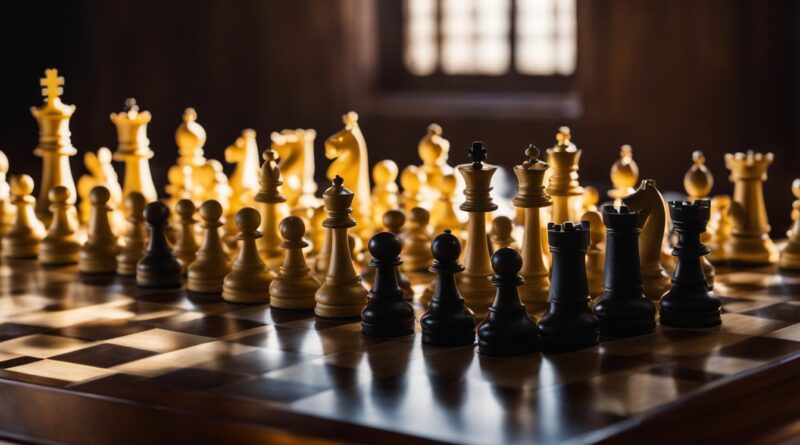Bishop and Pawns vs. Pawns in Chess
Welcome to our article on the fascinating endgame scenario in chess known as “Bishop and Pawns vs. Pawns.” In this strategic battle, one side has a bishop and a few pawns, while the other side only has pawns. The outcome of this endgame hinges on the positioning and movement of the pieces on the chessboard.
Key Takeaways:
- Chess endgame with bishop and pawns vs. pawns is a crucial strategic aspect.
- The bishop can move diagonally, while the pawns move forward and capture diagonally.
- Pawns win by safely reaching the other end, while the bishop wins by capturing all the pawns.
- Examples of winning moves include breakthrough and overloading the bishop’s defense.
- The king’s position plays a vital role in supporting the pawns or defending against the bishop.
How the Pieces Move
In the endgame involving the bishop and pawns versus pawns in chess, understanding how the pieces move is crucial for both players. Let’s take a closer look at the movements of the bishop and the pawns.
Bishop
The bishop is a powerful piece that can move any number of squares diagonally. It can navigate the chessboard efficiently and reach different areas of the board with ease. Whether it’s controlling key squares or setting up an attack on the opponent’s pawns, the bishop’s diagonal movement plays a vital role in this endgame.
Pawns
The pawns, on the other hand, have a more limited movement. They can only move one square forward at a time, except on their first move when they have the option to move two squares. When it comes to capturing, pawns can only capture diagonally. The goal for the pawns is to safely advance across the board, avoid being captured by the opponent’s bishop, and promote to a more powerful piece.
It’s important to note that in this endgame, the pawns move first, followed by the bishop. This turn-based movement adds an extra layer of strategy and calculation to the game.
Now that we understand the movement of the pieces, let’s delve into the winning conditions for both the pawns and the bishop in this endgame.
| Piece | Movement | Capture |
|---|---|---|
| Bishop | Diagonally any number of squares | Captures opponent’s pawns diagonally |
| Pawns | Forward 1 square (2 squares on first move) | Captures opponent’s pieces diagonally |
Winning Condition for Pawns
In the bishop and pawns vs. pawns endgame, the winning condition for the pawns is to safely advance and reach the other end of the board without being captured by the bishop. This involves strategic pawn movements and sacrifices to create opportunities for other pawns to make progress towards promotion. The pawns aim to overcome the bishop’s defensive positioning and secure a victory.
The pawns can employ various tactics to achieve their winning condition. One strategy is to create pawn breakthroughs by advancing them to critical squares, forcing the bishop to capture and allowing other pawns to advance. By sacrificing certain pawns, the remaining pawns can gain momentum and pose a greater threat to the bishop’s defense.
Table: Winning Condition for Pawns
| Pawn Strategy | Explanation |
|---|---|
| Pawn Breakthrough | Advancing a pawn to a critical square, forcing the bishop to capture and creating opportunities for other pawns to advance. |
| Sacrifices | Strategically sacrificing pawns to create momentum and pose a greater threat to the bishop’s defense. |
| Coordinated Movements | Coordinating the movements of multiple pawns to create a strong offensive against the bishop. |
In summary, the pawns’ winning condition in the bishop and pawns vs. pawns endgame is to safely reach the other end of the board without being captured by the bishop. This requires strategic pawn movements, breakthroughs, sacrifices, and coordinated efforts to overcome the bishop’s defense and secure a victory.
Winning Condition for Bishop
In this endgame scenario, the bishop has a clear winning condition – to capture all the pawns on the board. By strategically positioning itself and using its diagonal movement, the bishop aims to eliminate the pawns one by one, paving the way for a victory.
The bishop’s primary objective is to control the critical squares that the pawns need to pass through. This allows the bishop to put pressure on the pawns and restrict their movements. As the pawns advance, the bishop must anticipate their next moves and position itself accordingly to capture them efficiently.
The winning condition for the bishop requires careful maneuvering and calculation. It’s essential to identify the weaknesses in the pawn formation and exploit them tactically. By eliminating the pawns, the bishop can secure a victory and demonstrate the power of strategic positioning in chess endgames.
Table: Endgame Scenario
| Piece | Position | Action |
|---|---|---|
| Bishop | Controlled diagonal squares | Capture pawns |
| Pawn | Advancing towards the other end | Avoid capture and promote if possible |
| King | Support pawns and defend against bishop’s attacks | Strategically position for optimal defense |
The winning condition for the bishop showcases the importance of foresight and strategic thinking in chess. By understanding the movement capabilities of the bishop and utilizing its strengths, players can work towards a decisive victory in this endgame scenario.
Examples of Winning Moves
In the bishop and pawns vs. pawns endgame in chess, there are several winning moves that the pawns can employ to secure a victory against the bishop. One winning strategy involves creating breakthrough opportunities by advancing a pawn to a critical square.
For example, by advancing a pawn to a square that the bishop has to capture, the pawn can force the bishop to leave its defensive position and allow another pawn to advance further towards the other end of the board. This tactic creates opportunities for the pawns to outnumber the bishop and secure a win.
Another winning strategy is overloading the bishop’s defense by attacking multiple pawns simultaneously. By placing the pawns in a way that forces the bishop to choose between defending two or more pawns, the pawns can create a favorable scenario where at least one pawn can safely advance and eventually reach the other end.
Table: Examples of Winning Moves
| Pawn Position | Bishop Position | Description |
|---|---|---|
| d5 | f7 | Moving the pawn to d5 forces the bishop to capture it, allowing another pawn to advance. |
| e6 | f6 | Placing the pawns in a way that overloads the bishop’s defense, forcing it to choose between defending two pawns. |
| b7 | d5 | Making a breakthrough move, advancing the pawn to b7 and threatening the bishop’s position. |
Importance of King’s Position
In the bishop and pawns vs. pawns endgame, the positioning of the king plays a crucial role. The king must be strategically placed to support the advancement of the pawns or defend against the bishop’s attacks. Its ability to control important squares and create an effective blockade can significantly influence the outcome of the endgame.
A well-positioned king can provide the necessary protection for the advancing pawns. It can act as a shield, preventing the bishop from easily capturing the pawns and hindering their progress. By establishing a strong defensive position, the king allows the pawns to focus on their objective of reaching the other end of the board.
On the other hand, the king can also take an active role in supporting the pawns’ advancement. It can act as a reinforcement, moving alongside the pawns and creating a formidable force that the bishop must consider. By coordinating the movement of the king and the pawns, players can exert pressure on the bishop and create opportunities for decisive breakthroughs.
King’s Role in Defense
When defending against the bishop’s attacks, the king’s position becomes even more critical. It must be positioned in a way that allows it to quickly respond to threats and protect the pawns. By staying close to the pawns, the king can offer immediate support and counter any attempts by the bishop to capture the pawns.
Additionally, the king can strategically create a blockade to deny the bishop access to certain squares. By restricting the bishop’s movements and limiting its influence on the board, the king can effectively neutralize the bishop’s attacking potential. This defensive maneuver can buy the pawns valuable time to advance and secure a stronger position.
King’s Role in Offense
When taking the offensive approach, the king can actively assist the pawns in their advance. It can move alongside the pawns, protecting them and ensuring they have the necessary support to overcome the bishop’s defenses. By coordinating their movements, the king and the pawns can launch coordinated attacks, overwhelming the bishop and achieving a favorable outcome.
Overall, the king’s position in the bishop and pawns vs. pawns endgame is of utmost importance. Whether it’s defending the pawns or aiding in their advancement, the king’s strategic placement can significantly impact the outcome of the endgame. Players must carefully consider the positioning of their king and use it effectively to achieve success in this critical phase of the game.
Opposite-Colored Bishops Endgame
The opposite-colored bishops endgame is a unique and intriguing scenario in chess. It occurs when each side has a bishop on squares of opposite colors. These endgames are known for their difficulty in converting a small material advantage into a win and often result in a draw.
What makes the opposite-colored bishops endgame so fascinating is the contrast between the mobility and influence of the bishops. The bishops can only move on squares of their own color, which means they cannot directly target each other. This leads to a situation where both bishops operate independently, affecting different areas of the board.
The tendency towards a draw in opposite-colored bishops endgames arises from the fact that the bishops cannot directly control the squares of the opponent’s bishop. This creates a balance in the position, making it challenging for either side to break through and gain a decisive advantage. Consequently, opposite-colored bishops endgames often require precise and accurate play to convert any material advantage into a win.
Table: Examples of Opposite-Colored Bishops Endgame
| Position | Outcome |
|---|---|
| Equal material, pawns on both sides | Draw |
| One side with an extra pawn | Still likely to result in a draw |
| Both sides with a few pawns remaining | Imbalanced possibilities, but often ends in a draw |
As depicted in the examples in the table above, opposite-colored bishops endgames tend to lean towards a draw regardless of the material on the board. Players should be wary of this drawing tendency and carefully evaluate their options before committing to any aggressive or risky moves. It is essential to prioritize solid positional play and focus on improving the overall position rather than solely pursuing material advantage.
General Principles and Drawing Tendency
In chess endgames involving opposite-colored bishops, there are general principles to consider when strategizing for a win or a draw. One of the key principles is recognizing the drawing tendency of these endgames. Due to the nature of opposite-colored bishops, it can be challenging to convert a small material advantage into a decisive win.
When a player is down in material, they should focus on finding drawing chances in the endgame. This means creating positions and maneuvers that make it difficult for the opponent to make progress. The presence of opposite-colored bishops often leads to a positional balance that favors a draw. It is crucial to exploit the drawing tendency and seek opportunities to neutralize the opponent’s advantages.
To emphasize the drawing tendency, it is important to understand that even positions with an extra pawn may still result in a draw. The power of the opposite-colored bishops lies in their ability to control different color squares, restricting the opponent’s options. This can lead to situations where the extra pawn cannot be efficiently utilized to create a winning advantage.
Summary:
In opposite-colored bishops endgames, chess players should be mindful of the drawing tendency and adjust their strategies accordingly. Recognizing the difficulty of converting a small material advantage into a win, players should look for drawing chances and create positions that make it challenging for the opponent to make progress. Even positions with an extra pawn may still result in a draw due to the limitations imposed by opposite-colored bishops. By understanding and leveraging these general principles, players can navigate opposite-colored bishops endgames with more confidence and effectiveness.
Strategies with Bishop and Two Pawns in the Endgame
The endgame scenario of the bishop and two pawns against a bishop requires careful consideration and strategic planning. The outcome of this endgame heavily relies on factors such as the separation of the pawns, their position on the board, and the location of the bishop. To navigate this complex situation, players can adopt various strategies to either secure a win or ensure a draw.
One effective strategy is to create a “pawn chain” by placing the pawns on adjacent files. This formation restricts the opponent’s bishop and limits its mobility, allowing the pawns to advance safely. By supporting each other, the pawns can create a strong defensive structure that is difficult for the opposing bishop to penetrate.
Another approach involves splitting the pawns to create multiple “passers” – pawns that have a clear path to the other end of the board. This strategy forces the opposing bishop to divide its attention and make difficult choices. By advancing the passers while keeping the other pawns defended, players can seize opportunities to promote a pawn into a more powerful piece.
It’s important to consider the location of the bishop as well. If the opponent’s bishop is positioned on the same color square as the player’s pawns, it becomes easier to protect the pawns and create favorable exchanges. On the other hand, if the opponent’s bishop is on the opposite color square, players should focus on maintaining pawn structures that restrict the bishop’s influence.
FAQ
How do the bishop and pawns move in chess?
The bishop can move any number of squares diagonally, while the pawns can move one square forward (or two squares on their first move) and capture diagonally.
What is the winning condition for pawns in the bishop and pawns vs. pawns endgame?
The pawns win if they can safely reach the other end of the board without being immediately captured by the bishop.
What is the winning condition for the bishop in the bishop and pawns vs. pawns endgame?
The bishop wins by capturing all the pawns and strategically positioning itself to control the diagonal squares that the pawns need to pass through.
Can you provide examples of winning moves in this endgame?
Winning moves include advancing one pawn to a critical square, forcing the bishop to capture the pawn and allowing another pawn to advance. Overloading the bishop’s defense by attacking multiple pawns simultaneously is also a winning strategy.
How important is the king’s position in the bishop and pawns vs. pawns endgame?
The king plays a crucial role in this endgame by positioning itself strategically to support the pawns in their advance or defend against the bishop’s attacks. The king can also create a blockade to protect important squares and prevent the bishop’s influence.
What is the opposite-colored bishops endgame?
The opposite-colored bishops endgame occurs when each side has a bishop on opposite-colored squares. These endgames often result in a draw and are known for their difficulty in converting a small material advantage into a win.
What are the general principles and drawing tendencies in opposite-colored bishops endgames?
In opposite-colored bishops endgames, if a player is down in material, they should look for drawing chances. Additionally, even positions with an extra pawn may still result in a draw due to the nature of opposite-colored bishops endgames.
What strategies can be used in the bishop and two pawns vs. bishop endgame?
The outcome in this endgame depends on factors such as the separation and position of the pawns, as well as the location of the bishop. Different strategies can be employed based on the situation to either secure a win or ensure a draw.


